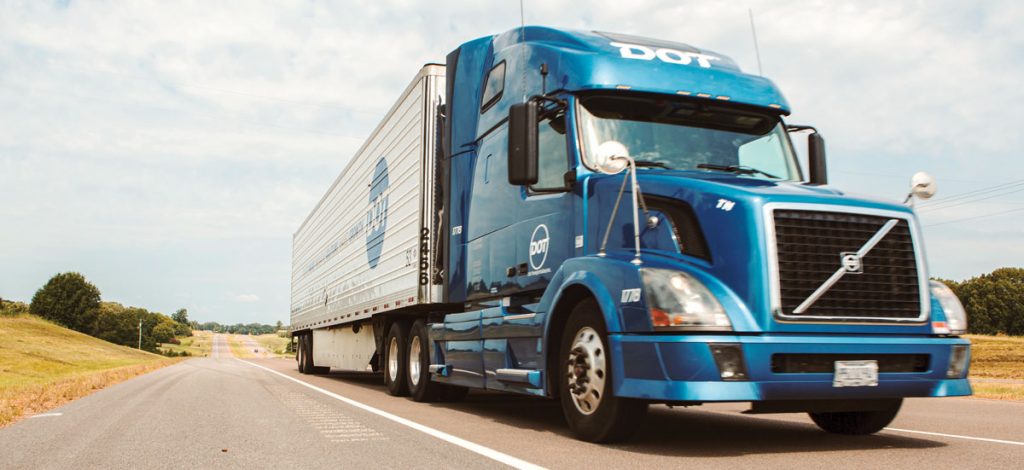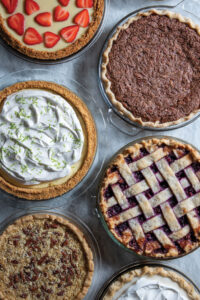One in four Illinoisans go hungry. This is especially true in rural areas of the state. The faces of hunger aren’t always those you expect, and many are facing food insecurity for the first time due to COVID-19.
Molly Delaney, Eastern Illinois Foodbank (EIF) vice president of development, shares the story of Lewis. Lewis, a freelance journalist, covered one of the first EIF drive-thru food distributions earlier this year. Delaney recalls helping direct traffic at a drive-thru distribution four weeks later.
“I saw Lewis in his car and thought he was back to cover the story,” says Delaney. “He was actually back as a client.”
His brother lost his job and moved in with Lewis and his wife. Due to the pandemic, between the three of them, they lost five jobs. Lewis couldn’t get unemployment benefits because his work was considered seasonal and they suddenly had no income.
Delaney recalls Lewis telling her, “Anyone can find themselves in this position. We had good jobs.” Before COVID, they were donors and gave to organizations like the food bank. Now, for the first time, they were having to use those same services.
Feeding Illinois
Feeding Illinois oversees eight food banks serving almost 2,700 local agencies and food programs across the state. As an affiliate of the Feeding America and No Kid Hungry programs, the organization is keenly aware of food insecurity – a term used to describe the lack of consistent, dependable access to enough food to maintain an active, healthy lifestyle.
According to Steve Ericson, Feeding Illinois executive director, in 2020 the group has seen a 34 percent increase in food insecure clients due to the pandemic. Of the 1.6 million rural residents in Illinois, more than 638,000 don’t know where they are going to find the food they need for themselves or their families. This is where food banks help fill the gap.
Even before the pandemic, small towns were seeing an increase in lack of access to grocery stores. Across the state are areas where dollar stores or gas station convenience stores are the only options for food.
“Once those small, locally-owned or family-owned grocery stores leave town, they are being replaced by a lot of dollar stores,” explains Ericson. “Those of us in urban or suburban areas are spoiled and take food access for granted. We can jump in our cars and have multiple choices in a relatively short period of time. In rural areas, you may have to drive a while before you find a town that actually has a full-blown grocery store.”
Ericson gives credit to dollar stores because if they have something to donate, they are often giving it to a local food pantry. However, dollar stores are not high-volume stores and don’t have many fresh foods, which are healthier options.
“In many small towns, there isn’t a food pantry or grocery outlet,” says Ericson. “It’s a double whammy. Folks that live there have nowhere to go. Those that are food insecure have nowhere to go for assistance.”
Feeding Illinois food banks have mobilized their food pantries. “It hopefully shows the community that there is a need,” explains Ericson. “None of us want to admit that we have that kind of need in our community, so sometimes we have to prove it first. Then, hopefully, there’s local interest from a group of churches or government organizations, or a combination of them, that decides to do something to help their neighbors. A lot of our pantries are faith-based, so they might establish something at a local church.”
According to Ericson, Feeding America and Feeding Illinois have aggressive goals to not only sustain the organizations but address some of the root causes for food insecurity and look for ways to shorten the lines. Many of the challenges deal with access and how to improve it.
“It really comes down to jobs, and if there’s no jobs in those communities, it’s a problem,” says Ericson. “You can tie it to the family farms and how much of agriculture has become commercialized. The very places where crops are grown to feed the world are experiencing hunger at higher rates. I think that’s the core cause of some of these smaller communities not having the economic engines they once did. So many jobs left along with the auxiliary businesses that go along with farming.
“I believe the best place to start is to figure out exactly what is causing it, how permanent it is and if it’s systemic. There’s a lot of talk about inequities. Where do those lie in terms of getting food accessible to everyone evenly? It’s not a one size fits all problem but unique state to state and maybe county to county. We need to tailor our programs to the community and hopefully gain community support so they can sustain themselves and we can just be the fuel in the engine that does that.”
Rural places matter
One of the biggest challenges is a numbers game. Small rural communities don’t add up to many people, so they don’t receive as much attention. Ericson explains that rural hunger hasn’t been as big a “blip on the radar” as other areas with larger populations. The numbers don’t draw attention to the problem like they do in urban areas.
“When you look at the whole state like I do, and Feeding America does, you see the collective numbers are something we need to do something about,” he says. “If one person is hungry in a county, that’s no different than having 1,000 people – we still need to address it. COVID has drawn attention to it and has escalated those numbers. I’m not sure it will ever go back down until some of these jobs return, if they do at all. It’s a very real issue for our food banks and agencies on the front line.”
Feeding Illinois food banks collaborate with local agencies to be a resource to all 102 counties in Illinois. Local agencies have the connections and food banks look for ways to support them.
“We spend a lot of time raising money, because a lot of things come down to money, to help build the capacity of those local agencies in their communities,” Ericson explains. “One of the biggest gaps food banks fill is assisting in establishing pantries and helping with their refrigeration or frozen capacity needs. We want them to be able to receive all the food resources they can and not worry about having enough space. We can build big food banks, but it does no good if we can’t go anywhere with the food.”
The food bank mentality has changed from warehousing, to distributing the food or directly connecting pantries with resources like retail stores, if available. The food bank isn’t the middleman but the support agency to local groups.
Eastern Illinois Foodbank is one of eight food banks serving Illinois. EIF is the primary food source for food pantries, soup kitchens and other programs in 18 eastern Illinois counties. It partners with retailers Walmart, Aldi and others to source fresh foods.
Delaney says items are pulled from retail shelves that may be getting close to the date marked on them but are good longer than that. Volunteers sort and repack the items to move them out quickly. Other products come into the warehouse from a variety of places and all product is inventoried. Partner agencies look at the inventory and order what they need. They also have boxes from the USDA Coronavirus Food Assistance Program (CFAP) which partner agencies can utilize or not. Forklift drivers then “pick” the orders, place them on palettes, wrap and they are ready to go out.
EIF received a grant allowing them to purchase a beverage truck, not for beverages but for easy access to deliver food boxes. The sides of the truck roll up making distribution from the truck much easier. Instead of traveling to a community, unloading the truck and then reloading boxes into client’s cars, the beverage truck allows distribution directly from the truck, allowing it to move on to the next community.
“We can go in where the need is greatest and get in and out in a shorter period of time,” Delaney explains. “It allows us to do more distributions in a day. We use it for several communities the same day in areas where there is less population because we won’t need to return to the food bank to reload.”
Access to food has been amplified by the pandemic. For EIF, there was a 26 percent increase in the pounds of food distributed from January through August. On Oct. 21, the numbers had already exceeded those of September and keep going up. It has seen an almost 20 percent increase in clients who have never used their services before.
“The hardest thing is not being able to predict any of this,” says Delaney. “We try to prepare and forecast but then have to wait to see what will happen.”
Faces of hunger
Feeding Illinois, its affiliate food banks and partnering agencies, stress there isn’t one demographic of individuals and families they serve but a broad cross-section. One in four of those seeking food have usual incomes above $50,000. It’s a hidden problem. It is a big step for individuals to admit they need help, and all agencies are working to ensure there isn’t a stigma tied to it.
Before COVID, pantries were making the experience more like shopping by giving choices. Clients were choosing what they wanted to eat based on what was available. “I think that does more for people’s dignity and self-respect and actually makes the food go further,” Ericson explains. “Instead of us assuming what we think they should be eating, or like to eat, we let them choose what they know they’ll use. I’ve seen firsthand how people are very respectful of those behind them in line and oftentimes won’t take as much as they maybe could because they know others need it too.”
Ericson says they’ve gone a long way to educate employees and volunteers to be mindful of treating folks like they would want to be treated.
“Nobody wants to use a food pantry by choice,” he says. “They are there because they’ve probably exhausted all other options. It’s not just food pantries either; it could be soup kitchens. Kids aren’t being signed up for reduced or free lunch because they think it’s great food, it’s out of necessity.”
Public perception of the food insecure population is a challenge and getting people out of the cycle of needing food varies by situation. Sometimes it’s about medicine, healthcare, living arrangements, employment or all of the above. It goes back to understanding the circumstances people are dealing with, and a food pantry is usually where they turn after other resources are exhausted.
Elizabeth Garman, Northern Illinois Food Bank communications manager, shares two stories.
As the primary breadwinner for her household of five, Vicki and her husband were able to provide comfortably for their family. However, both were furloughed due to the pandemic and months later remain unemployed. While their bills continue to mount, she is thankful for Northern Illinois Food Bank’s Pop-Up Market and knowing she has good food to feed her family amid all the uncertainty.
For Mandi, the pandemic also brought major changes. After her parents moved in with her family in 2019, she had no idea they would all would be working, learning and living from home. Their expenditures went up as income decreased. Mandi is a freelance worker and has been without income since March. Her husband took a pay cut, and they fear he could lose his job in his company’s upcoming round of layoffs. Mandi is grateful she has been able to pick up boxes of fresh produce, protein and dairy products for her family thanks to another Northern Illinois Food Bank Pop-Up Market.
How to help
Money is always needed – Feeding America and its affiliates can provide 10 meals for every dollar donated. The increase in demand is requiring food banks to purchase an increasing amount of food at often higher prices. During summer, fresh foods are more locally available but in winter months, Feeding Illinois and its food banks look to other resources to purchase fresh food and it’s a challenge to find fresh produce. The food banks want to offer healthy, nutritionally-dense items and place emphasis on fresh fruits and vegetables as well as protein, dairy, meats and eggs. Ericson says they would rather spend the money to get more nutritious food than just take whatever they can get.
Individuals can also volunteer. Drive-thru distributions require volunteers to load boxes and bags. At food banks, individuals are needed to sort and repack food.
“Pre-COVID, post-COVID or during it, everyone has their comfortability with engagement and how they’d like to help, be it money or volunteering and we are happy to help facilitate that,” says Ericson. “It doesn’t have to be at the food bank. Maybe it’s at your local facility and we are happy to make those connections. We need advocates more than anything and it usually starts with volunteering. We welcome any kind of support and everything starts with a conversation.”
PHOTO COURTESY OF NORTHERN ILLINOIS FOOD BANK
How food banks work
Delivering millions of pounds of food across the state requires coordination and commitment. Additionally, feeding hungry people requires funding and well-tuned operations to execute everything from procurement, to storage, evaluation, transportation and delivery.
Food is donated and/or purchased from local food companies, government agencies, food drives, special purchases and Feeding America.
Once accepted, food is picked up by or delivered to food banks. Food banks must maintain trucks and employ drivers to ensure safe, efficient transportation.
Food banks store and distribute food. Once accepted, the food is inspected for quality, sorted and repacked for distribution. This includes refrigerated storage for perishable items such as fresh fruits and vegetables, meat, eggs and dairy products. Collectively, in 2017, Feeding Illinois food banks distributed 247 million pounds of food.
Agencies such as shelters, soup kitchens and food pantries, receive food from the food banks and provide food assistance to clients in need efficiently, serving as many in their community as possible.
Food reaches those in need. Feeding Illinois network members feed over 1.4 million hungry each year, including 605,000 children.
Source: Feeding Illinois









